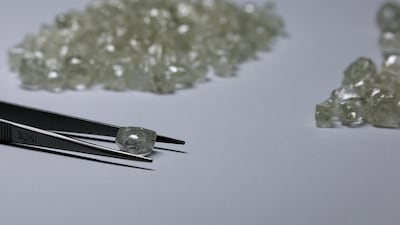For the first time in a decade, diamond production is falling behind demand – good news for the African countries who supply more than half the world’s gemstones.
Annual diamond output is expected to average about 127 million carats between 2021 and 2026, according to Paul Zimnisky Diamond Analytics. Production in 2019, when pre-pandemic conditions still prevailed, saw 142 million carats brought to market.
Around 152 million carats were mined in 2017, the recent high-water mark. However, production fell to a three-decade low last year with just 119 million carats produced.
“An oversupplied diamond supply chain was the biggest culprit for industry underperformance for the most of last decade,” Mr Zimnisky says. “All-time high diamond prices in 2011 was the primary catalyst leading to the oversupply.”
Globally, diamond production fell 20 per cent in 2020 while rough diamond sales plummeted 33 per cent, according to a report by Bain & Company. The restrictions introduced to curb the spread of the coronavirus led diamond producing countries such as Botswana, Lesotho and Namibia to shut down their operations while dealers from international diamond centres such as Antwerp, Dubai and India could not access supply.
Now, the industry is poised for correction as miners and producers have begun limiting supply to match demand.
Industry leader De Beers Group, which supplies almost a third of world supply, says it now has fewer diamonds available after reducing its inventories. The Botswana-based company said it sold 13.5 million carats, against production of 7.2 million carats, during the first quarter of this year.
As production fell, demand seems to have increased.
“We saw the continuation of good rough diamond demand during our second sales cycle of 2021 on the back of positive consumer demand for diamond jewellery,” said Bruce Cleaver, chief executive of De Beers Group in a statement.
Russian diamond miner Alrosa, the world’s second largest producer, also sold almost twice the number of diamonds than it produced over the past year – 7,5 million carats mined but 13,5 million sold. The company's first-quarter sales are up 65 per cent compared to the same period last year.
Demand for diamonds is rebounding amid a broader economic recovery and a return in consumer confidence in key markets.
US jewellery sales in March soared by 106 per cent annually, helped by stimulus payments, according to diamond industry analyst firm Rapaport.
All this bodes well for an industry that has struggled to regain its sparkle in recent years. For African producers, the possibility of fresh diamond investment is welcome.
“I think we will see a new interest in both green and brown fields diamond exploration due to increasing diamond demand,” says James Campbell, managing director of Botswana Diamonds, an exploration company.
The political risk historically associated with African countries has now largely passed southern Africa. Even Angola, which was once seen as the major origin of ‘blood diamonds’, has enjoyed years of peace and stable governance.
“Southern Africa is also highly prospective for diamonds, with Botswana having low political risk too and other countries in the region having gradually reducing political risk,” Mr Campbell says.
Africa also leads in the discovery of large diamonds; the most recent was a 130-carat gem found in Angola, by the Australian-listed Lucapa Diamond Company. Provisionally valued at $170 million, this is the seventh stone clocking in above 100 carats to be found this year so far.
While full mining production now resumes, it is unlikely to catch up with demand anytime soon.
“Low diamond inventories combined with a post-vaccinated economy charged with pent-up wedding demand sets the industry up well for the remainder of 2021,” Mr Zimnisky says. "The recent move up in diamond prices is the strongest I have seen in years.”







